Bob Zhang
Palmprint De-Identification Using Diffusion Model for High-Quality and Diverse Synthesis
Apr 11, 2025



Abstract:Palmprint recognition techniques have advanced significantly in recent years, enabling reliable recognition even when palmprints are captured in uncontrolled or challenging environments. However, this strength also introduces new risks, as publicly available palmprint images can be misused by adversaries for malicious activities. Despite this growing concern, research on methods to obscure or anonymize palmprints remains largely unexplored. Thus, it is essential to develop a palmprint de-identification technique capable of removing identity-revealing features while retaining the image's utility and preserving non-sensitive information. In this paper, we propose a training-free framework that utilizes pre-trained diffusion models to generate diverse, high-quality palmprint images that conceal identity features for de-identification purposes. To ensure greater stability and controllability in the synthesis process, we incorporate a semantic-guided embedding fusion alongside a prior interpolation mechanism. We further propose the de-identification ratio, a novel metric for intuitive de-identification assessment. Extensive experiments across multiple palmprint datasets and recognition methods demonstrate that our method effectively conceals identity-related traits with significant diversity across de-identified samples. The de-identified samples preserve high visual fidelity and maintain excellent usability, achieving a balance between de-identification and retaining non-identity information.
FedPalm: A General Federated Learning Framework for Closed- and Open-Set Palmprint Verification
Mar 05, 2025



Abstract:Current deep learning (DL)-based palmprint verification models rely on centralized training with large datasets, which raises significant privacy concerns due to biometric data's sensitive and immutable nature. Federated learning~(FL), a privacy-preserving distributed learning paradigm, offers a compelling alternative by enabling collaborative model training without the need for data sharing. However, FL-based palmprint verification faces critical challenges, including data heterogeneity from diverse identities and the absence of standardized evaluation benchmarks. This paper addresses these gaps by establishing a comprehensive benchmark for FL-based palmprint verification, which explicitly defines and evaluates two practical scenarios: closed-set and open-set verification. We propose FedPalm, a unified FL framework that balances local adaptability with global generalization. Each client trains a personalized textural expert tailored to local data and collaboratively contributes to a shared global textural expert for extracting generalized features. To further enhance verification performance, we introduce a Textural Expert Interaction Module that dynamically routes textural features among experts to generate refined side textural features. Learnable parameters are employed to model relationships between original and side features, fostering cross-texture-expert interaction and improving feature discrimination. Extensive experiments validate the effectiveness of FedPalm, demonstrating robust performance across both scenarios and providing a promising foundation for advancing FL-based palmprint verification research.
PhenoProfiler: Advancing Phenotypic Learning for Image-based Drug Discovery
Feb 26, 2025Abstract:In the field of image-based drug discovery, capturing the phenotypic response of cells to various drug treatments and perturbations is a crucial step. However, existing methods require computationally extensive and complex multi-step procedures, which can introduce inefficiencies, limit generalizability, and increase potential errors. To address these challenges, we present PhenoProfiler, an innovative model designed to efficiently and effectively extract morphological representations, enabling the elucidation of phenotypic changes induced by treatments. PhenoProfiler is designed as an end-to-end tool that processes whole-slide multi-channel images directly into low-dimensional quantitative representations, eliminating the extensive computational steps required by existing methods. It also includes a multi-objective learning module to enhance robustness, accuracy, and generalization in morphological representation learning. PhenoProfiler is rigorously evaluated on large-scale publicly available datasets, including over 230,000 whole-slide multi-channel images in end-to-end scenarios and more than 8.42 million single-cell images in non-end-to-end settings. Across these benchmarks, PhenoProfiler consistently outperforms state-of-the-art methods by up to 20%, demonstrating substantial improvements in both accuracy and robustness. Furthermore, PhenoProfiler uses a tailored phenotype correction strategy to emphasize relative phenotypic changes under treatments, facilitating the detection of biologically meaningful signals. UMAP visualizations of treatment profiles demonstrate PhenoProfiler ability to effectively cluster treatments with similar biological annotations, thereby enhancing interpretability. These findings establish PhenoProfiler as a scalable, generalizable, and robust tool for phenotypic learning.
Deep Learning in Palmprint Recognition-A Comprehensive Survey
Jan 02, 2025



Abstract:Palmprint recognition has emerged as a prominent biometric technology, widely applied in diverse scenarios. Traditional handcrafted methods for palmprint recognition often fall short in representation capability, as they heavily depend on researchers' prior knowledge. Deep learning (DL) has been introduced to address this limitation, leveraging its remarkable successes across various domains. While existing surveys focus narrowly on specific tasks within palmprint recognition-often grounded in traditional methodologies-there remains a significant gap in comprehensive research exploring DL-based approaches across all facets of palmprint recognition. This paper bridges that gap by thoroughly reviewing recent advancements in DL-powered palmprint recognition. The paper systematically examines progress across key tasks, including region-of-interest segmentation, feature extraction, and security/privacy-oriented challenges. Beyond highlighting these advancements, the paper identifies current challenges and uncovers promising opportunities for future research. By consolidating state-of-the-art progress, this review serves as a valuable resource for researchers, enabling them to stay abreast of cutting-edge technologies and drive innovation in palmprint recognition.
Long-Range Biometric Identification in Real World Scenarios: A Comprehensive Evaluation Framework Based on Missions
Sep 03, 2024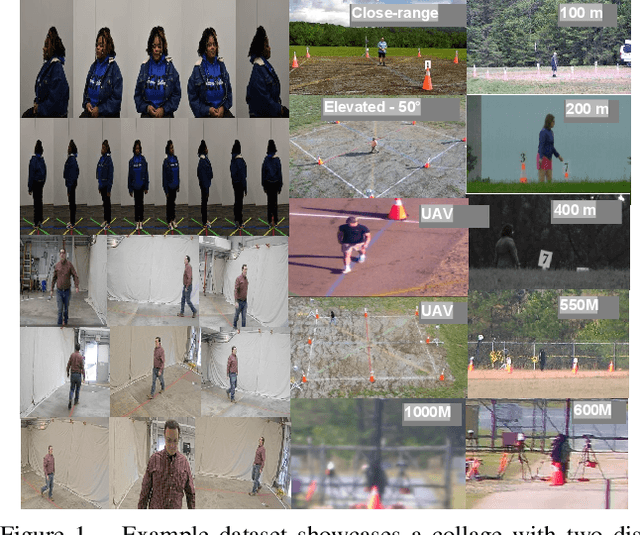
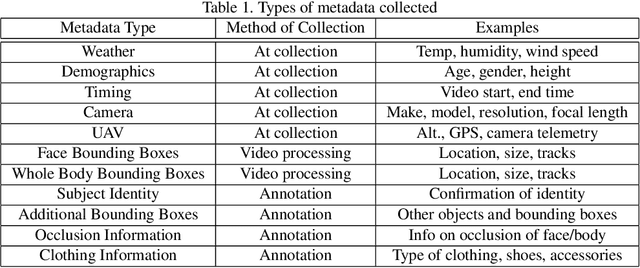
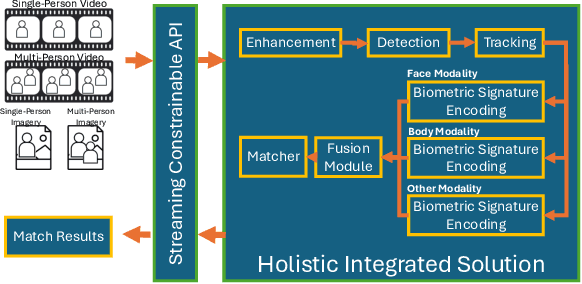
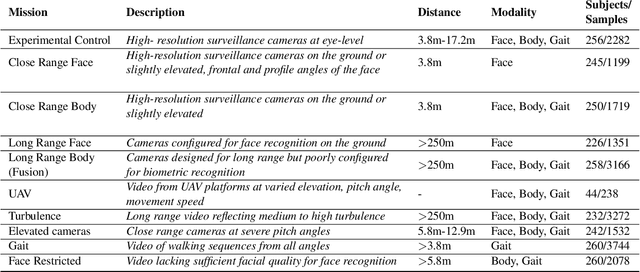
Abstract:The considerable body of data available for evaluating biometric recognition systems in Research and Development (R\&D) environments has contributed to the increasingly common problem of target performance mismatch. Biometric algorithms are frequently tested against data that may not reflect the real world applications they target. From a Testing and Evaluation (T\&E) standpoint, this domain mismatch causes difficulty assessing when improvements in State-of-the-Art (SOTA) research actually translate to improved applied outcomes. This problem can be addressed with thoughtful preparation of data and experimental methods to reflect specific use-cases and scenarios. To that end, this paper evaluates research solutions for identifying individuals at ranges and altitudes, which could support various application areas such as counterterrorism, protection of critical infrastructure facilities, military force protection, and border security. We address challenges including image quality issues and reliance on face recognition as the sole biometric modality. By fusing face and body features, we propose developing robust biometric systems for effective long-range identification from both the ground and steep pitch angles. Preliminary results show promising progress in whole-body recognition. This paper presents these early findings and discusses potential future directions for advancing long-range biometric identification systems based on mission-driven metrics.
From Data to Insights: A Covariate Analysis of the IARPA BRIAR Dataset for Multimodal Biometric Recognition Algorithms at Altitude and Range
Sep 03, 2024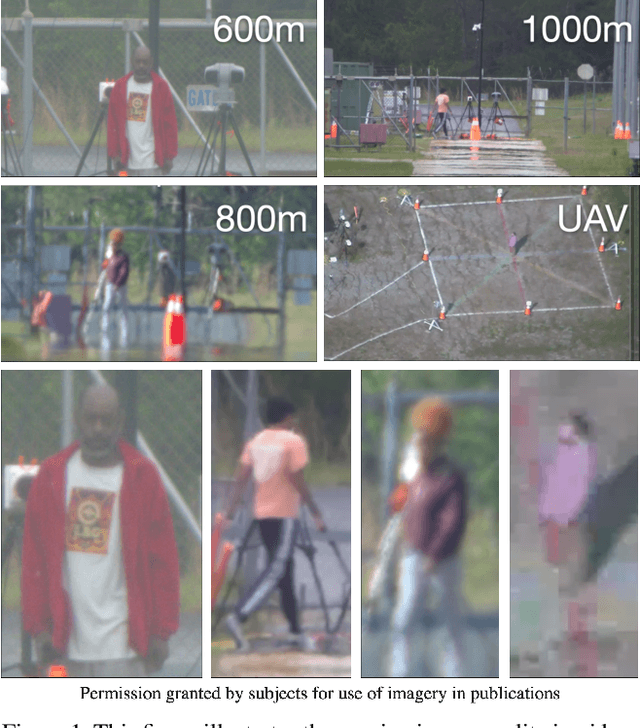


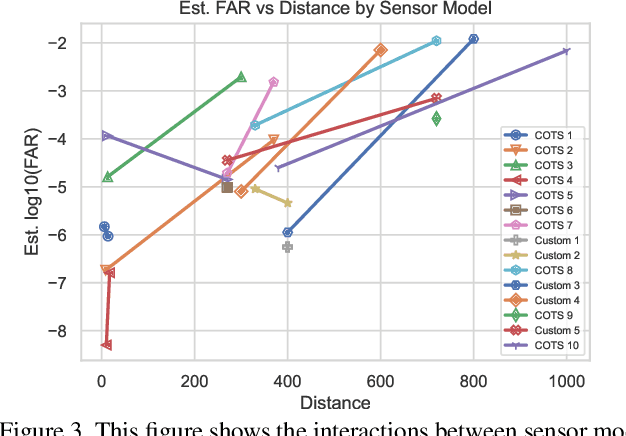
Abstract:This paper examines covariate effects on fused whole body biometrics performance in the IARPA BRIAR dataset, specifically focusing on UAV platforms, elevated positions, and distances up to 1000 meters. The dataset includes outdoor videos compared with indoor images and controlled gait recordings. Normalized raw fusion scores relate directly to predicted false accept rates (FAR), offering an intuitive means for interpreting model results. A linear model is developed to predict biometric algorithm scores, analyzing their performance to identify the most influential covariates on accuracy at altitude and range. Weather factors like temperature, wind speed, solar loading, and turbulence are also investigated in this analysis. The study found that resolution and camera distance best predicted accuracy and findings can guide future research and development efforts in long-range/elevated/UAV biometrics and support the creation of more reliable and robust systems for national security and other critical domains.
CDIMC-net: Cognitive Deep Incomplete Multi-view Clustering Network
Mar 28, 2024Abstract:In recent years, incomplete multi-view clustering, which studies the challenging multi-view clustering problem on missing views, has received growing research interests. Although a series of methods have been proposed to address this issue, the following problems still exist: 1) Almost all of the existing methods are based on shallow models, which is difficult to obtain discriminative common representations. 2) These methods are generally sensitive to noise or outliers since the negative samples are treated equally as the important samples. In this paper, we propose a novel incomplete multi-view clustering network, called Cognitive Deep Incomplete Multi-view Clustering Network (CDIMC-net), to address these issues. Specifically, it captures the high-level features and local structure of each view by incorporating the view-specific deep encoders and graph embedding strategy into a framework. Moreover, based on the human cognition, i.e., learning from easy to hard, it introduces a self-paced strategy to select the most confident samples for model training, which can reduce the negative influence of outliers. Experimental results on several incomplete datasets show that CDIMC-net outperforms the state-of-the-art incomplete multi-view clustering methods.
Open-Vocabulary Calibration for Vision-Language Models
Feb 15, 2024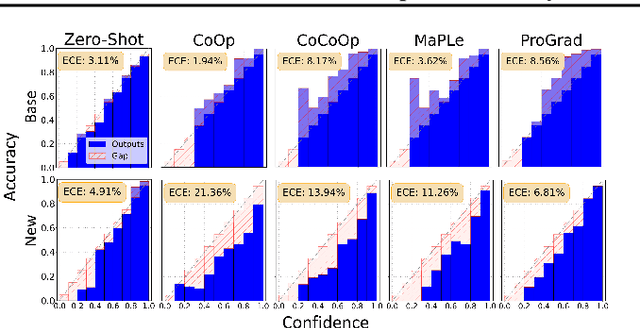

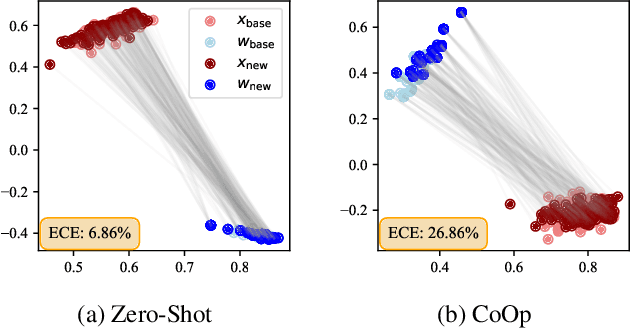
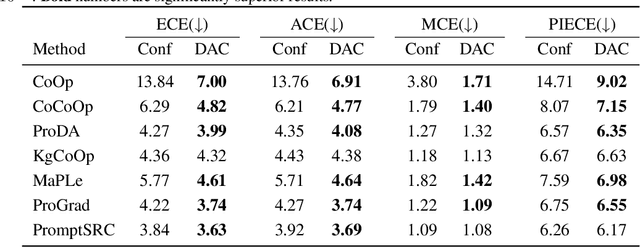
Abstract:Vision-language models (VLMs) have emerged as formidable tools, showing their strong capability in handling various open-vocabulary tasks in image recognition, text-driven visual content generation, and visual chatbots, to name a few. In recent years, considerable efforts and resources have been devoted to adaptation methods for improving downstream performance of VLMs, particularly on parameter-efficient fine-tuning methods like prompt learning. However, a crucial aspect that has been largely overlooked is the confidence calibration problem in fine-tuned VLMs, which could greatly reduce reliability when deploying such models in the real world. This paper bridges the gap by systematically investigating the confidence calibration problem in the context of prompt learning and reveals that existing calibration methods are insufficient to address the problem, especially in the open-vocabulary setting. To solve the problem, we present a simple and effective approach called Distance-Aware Calibration (DAC), which is based on scaling the temperature using as guidance the distance between predicted text labels and base classes. The experiments with 7 distinct prompt learning methods applied across 11 diverse downstream datasets demonstrate the effectiveness of DAC, which achieves high efficacy without sacrificing the inference speed.
Optimization-Free Test-Time Adaptation for Cross-Person Activity Recognition
Oct 28, 2023Abstract:Human Activity Recognition (HAR) models often suffer from performance degradation in real-world applications due to distribution shifts in activity patterns across individuals. Test-Time Adaptation (TTA) is an emerging learning paradigm that aims to utilize the test stream to adjust predictions in real-time inference, which has not been explored in HAR before. However, the high computational cost of optimization-based TTA algorithms makes it intractable to run on resource-constrained edge devices. In this paper, we propose an Optimization-Free Test-Time Adaptation (OFTTA) framework for sensor-based HAR. OFTTA adjusts the feature extractor and linear classifier simultaneously in an optimization-free manner. For the feature extractor, we propose Exponential DecayTest-time Normalization (EDTN) to replace the conventional batch normalization (CBN) layers. EDTN combines CBN and Test-time batch Normalization (TBN) to extract reliable features against domain shifts with TBN's influence decreasing exponentially in deeper layers. For the classifier, we adjust the prediction by computing the distance between the feature and the prototype, which is calculated by a maintained support set. In addition, the update of the support set is based on the pseudo label, which can benefit from reliable features extracted by EDTN. Extensive experiments on three public cross-person HAR datasets and two different TTA settings demonstrate that OFTTA outperforms the state-of-the-art TTA approaches in both classification performance and computational efficiency. Finally, we verify the superiority of our proposed OFTTA on edge devices, indicating possible deployment in real applications. Our code is available at \href{https://github.com/Claydon-Wang/OFTTA}{this https URL}.
Physics-Driven Spectrum-Consistent Federated Learning for Palmprint Verification
Aug 01, 2023Abstract:Palmprint as biometrics has gained increasing attention recently due to its discriminative ability and robustness. However, existing methods mainly improve palmprint verification within one spectrum, which is challenging to verify across different spectrums. Additionally, in distributed server-client-based deployment, palmprint verification systems predominantly necessitate clients to transmit private data for model training on the centralized server, thereby engendering privacy apprehensions. To alleviate the above issues, in this paper, we propose a physics-driven spectrum-consistent federated learning method for palmprint verification, dubbed as PSFed-Palm. PSFed-Palm draws upon the inherent physical properties of distinct wavelength spectrums, wherein images acquired under similar wavelengths display heightened resemblances. Our approach first partitions clients into short- and long-spectrum groups according to the wavelength range of their local spectrum images. Subsequently, we introduce anchor models for short- and long-spectrum, which constrain the optimization directions of local models associated with long- and short-spectrum images. Specifically, a spectrum-consistent loss that enforces the model parameters and feature representation to align with their corresponding anchor models is designed. Finally, we impose constraints on the local models to ensure their consistency with the global model, effectively preventing model drift. This measure guarantees spectrum consistency while protecting data privacy, as there is no need to share local data. Extensive experiments are conducted to validate the efficacy of our proposed PSFed-Palm approach. The proposed PSFed-Palm demonstrates compelling performance despite only a limited number of training data. The codes will be released at https://github.com/Zi-YuanYang/PSFed-Palm.
 Add to Chrome
Add to Chrome Add to Firefox
Add to Firefox Add to Edge
Add to Edge